How to Refrigerate Your Food the Right Way
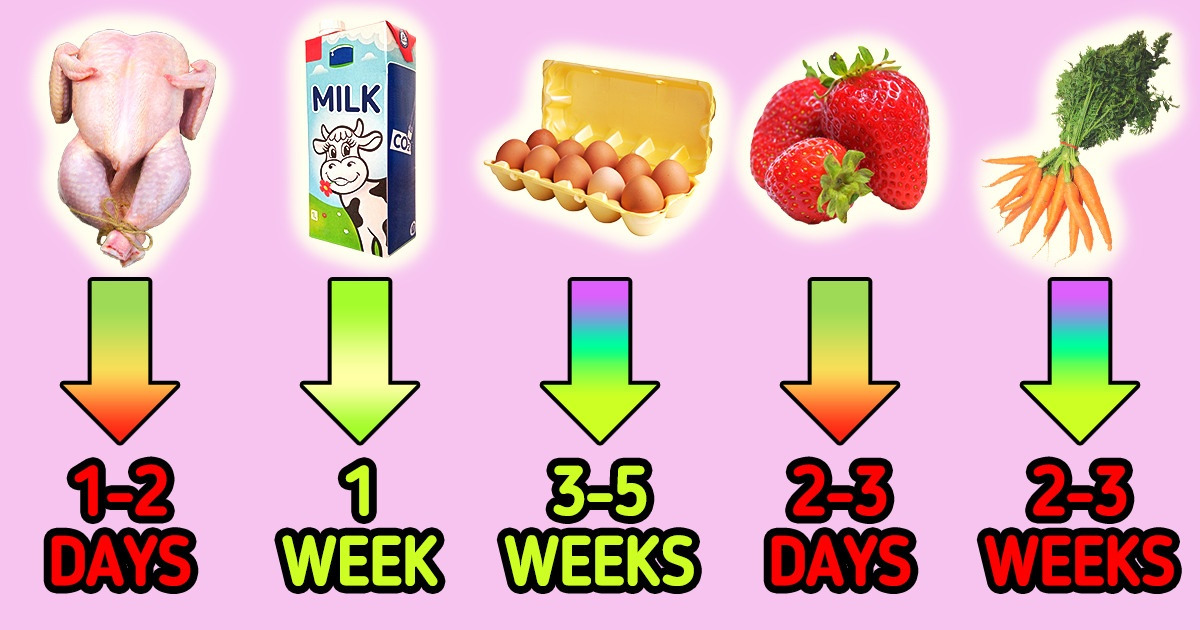
Food that we put in our fridge can often go bad if it’s not properly stored. But it’s not just that, it can often affect the other products in the fridge, making them spoil faster. To avoid this, there are many things that you can do, like placing the food in the right container, watching out for expiration dates, and keeping the optimal temperature inside the fridge. This will help the food stay safe for a long time while keeping its quality. However, not all products are the same, so their fridge life is different. Even the way they should be placed can vary.
5-Minute Crafts made this guide to give you some tips on how to refrigerate your food the right way.
1. General tips
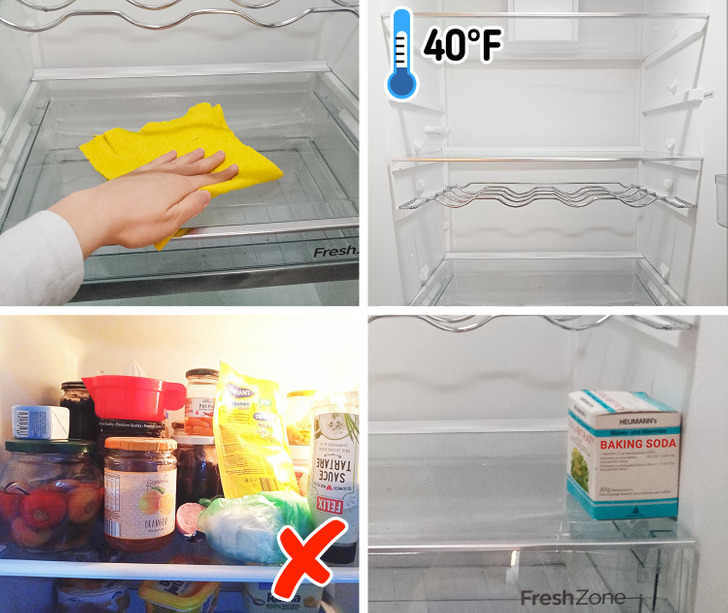
- Clean the fridge — you can do this once a week or when it gets dirty, but a full cleaning should be done every 3 months. Take out the trays and wash them with hot, soapy water, but be careful when you are placing them back since they need to be completely dry. Otherwise, if the water gets between the edges, mold and mildew can grow.
- Keep an optimal temperature (below 40°F or 4.4°C) — this will not allow bacteria growth. You can also place a thermometer to be sure that the right temperature is maintained. Put it on the second shelf from the top.
- Don’t overstock — the fridge has to have a flow of air in order to work properly. Don’t put too much food on the shelves and make sure there is enough room in between the products (at least half an inch). Also, avoid putting things against the sides or the back of the fridge.
- Keep an opened box of baking soda in the fridge (optional) — this can make the fridge smell fresh and you can place it on the second or third shelf. Replace it every 3 months.
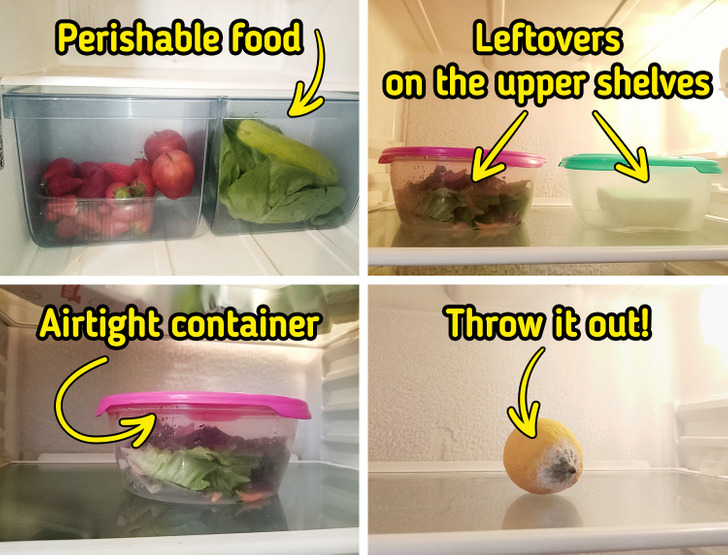
Here are some tips on how to refrigerate food:
- Be sure to store the perishable food quickly and not keep it at room temperature for more than 2 hours.
- If you are wondering if should you put the leftovers in the fridge while they are still warm, the answer is yes, as modern refrigerators are built this way. But you need to put them in smaller, airtight containers and on the top shelf where the temperature is the most consistent.
- The food should be placed in covered containers or wrapped and then stored in the fridge.
- If the food is moldy, put it in a bag and throw it out. Clean the container and check if the mold spread onto other produce (especially vegetables and fruits because the mold spores can grow quickly on them).
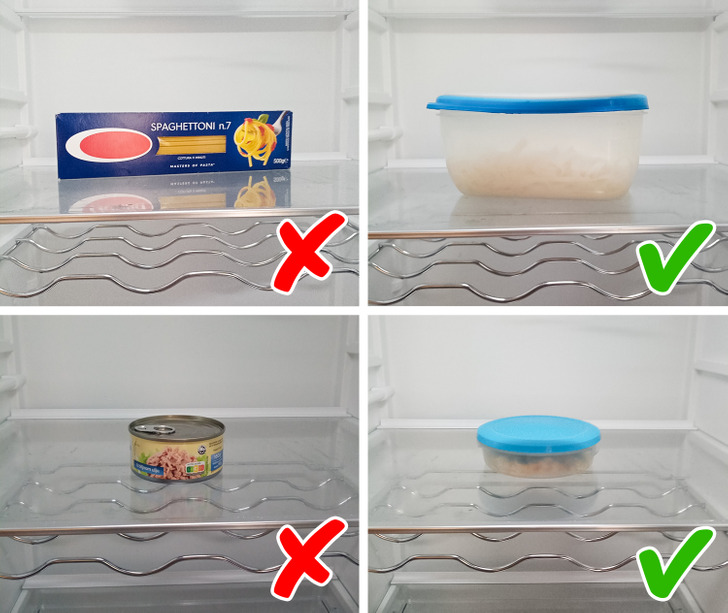
- Canned goods need to be put in clean containers and placed in a fridge after opening.
- Cooked pasta needs to be placed in the fridge, while dry pasta and bread should not. However, some people who live in areas with high humidity store bread in the fridge because it can protect it from developing mold.
2. Fridge compartments and their uses
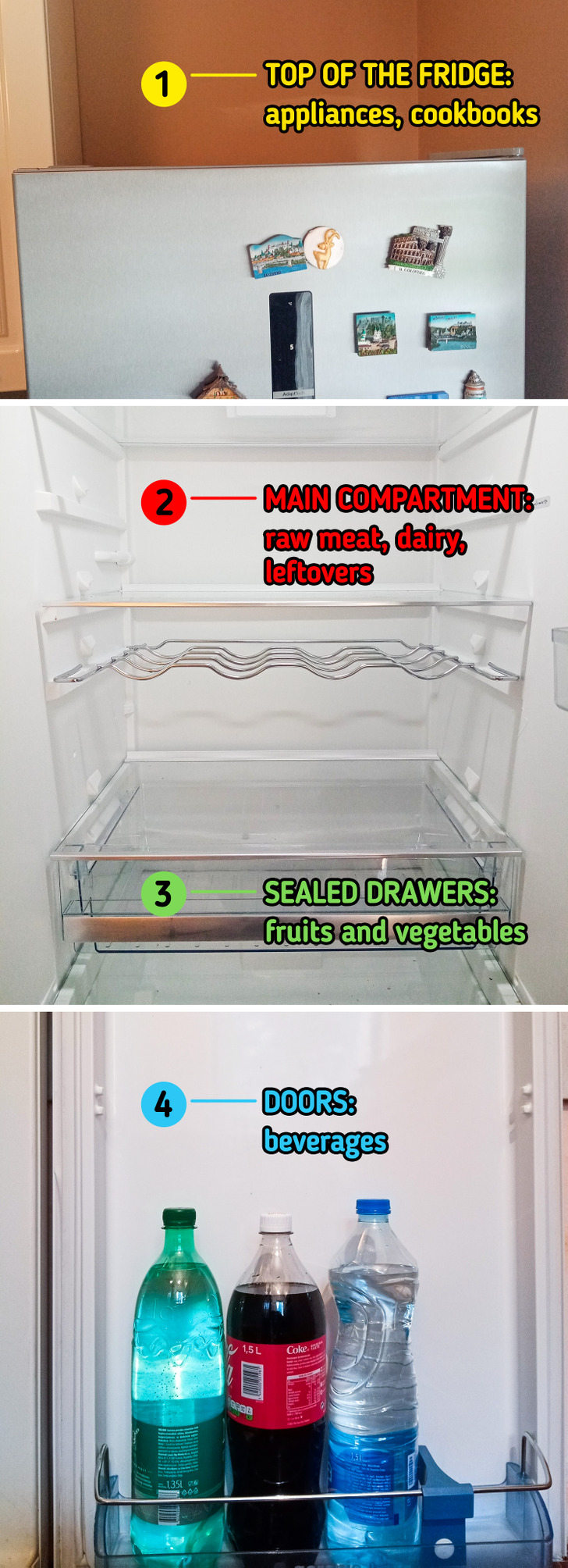
Each compartment regulates the temperature differently and there are several of them:
- Main area — this includes more than one shelf and is where the most food is stored. Place raw meat, dairy, and eggs on the lower shelves, as the temperature tends to be colder here. The upper shelf has a more consistent temperature and prepared meals, leftovers, drinks, and herbs can be stored here.
- Doors — you can put some items here that won’t go bad as fast, like drinks and water. Don’t place milk here because the temperature is not consistent.
- Sealed drawers — this compartment is usually where the fruits and vegetables should go, and it’s not recommended to store them with meat because of the cross-contamination risk.
- Top of the fridge — some people put items like beverages, bread, or coffee here, which is not advisable since the heat from the fridge can spoil them. Place non-food items up here, like appliances or cookbooks.
3. Raw meat, fish, and poultry
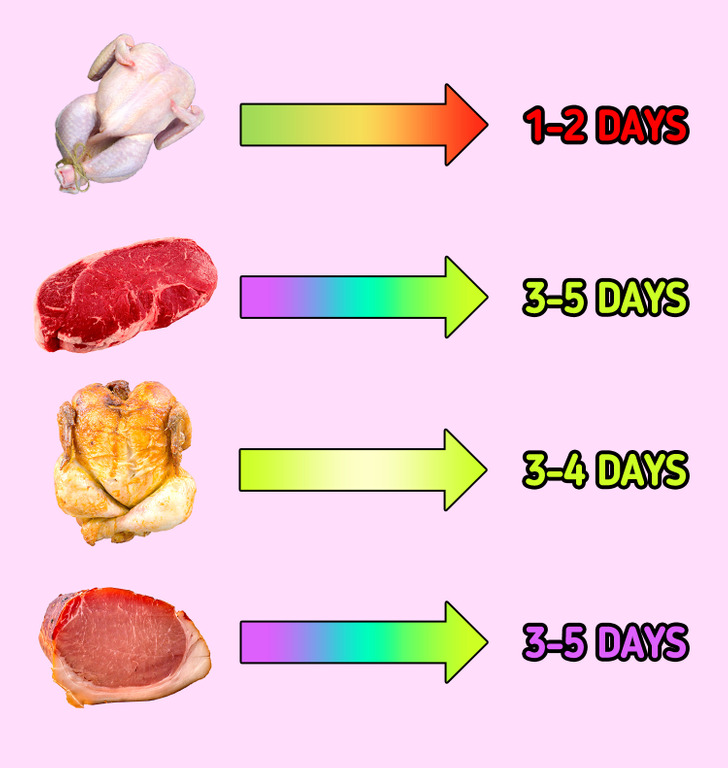
Put any raw meat in a container or on a plate to avoid dripping any excess juice from it. It’s not recommended to unwrap it until you use it for cooking. It’s best to place this close to the bottom because the area is a bit cooler and darker.
- Raw ground meat, poultry, seafood, and a variety of other meats (liver, tongue, etc.): 1-2 days (if frozen, ground beef: 4 months; a whole chicken: 12 months; fish: 3-8 months; shellfish: 3-12 months)
- Raw roasts, steaks, chops, beef, veal, and lamb: 3-5 days (if frozen, pork: 6 months; beef: 12 months)
- Cooked poultry, seafood, and other meat: 3-4 days (if frozen: beef and pork: 2-3 months; chicken: 4 months; fish: 3 months)
- Fresh, uncured ham (not cooked): 3-5 days; cooked ham: 3-4 days
Note: If the raw meat isn’t prepared within a few days (as stated above), it should be placed in a freezer. Use freezer bags for it and remove as much air as possible.
4. Dairy and eggs
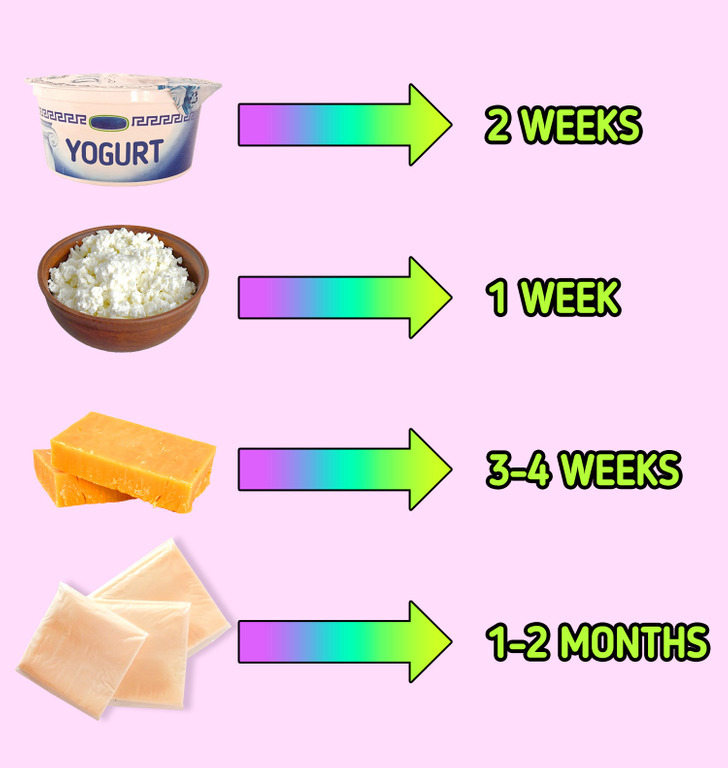
Here is a list of some dairy products and the time they can spend in the fridge:
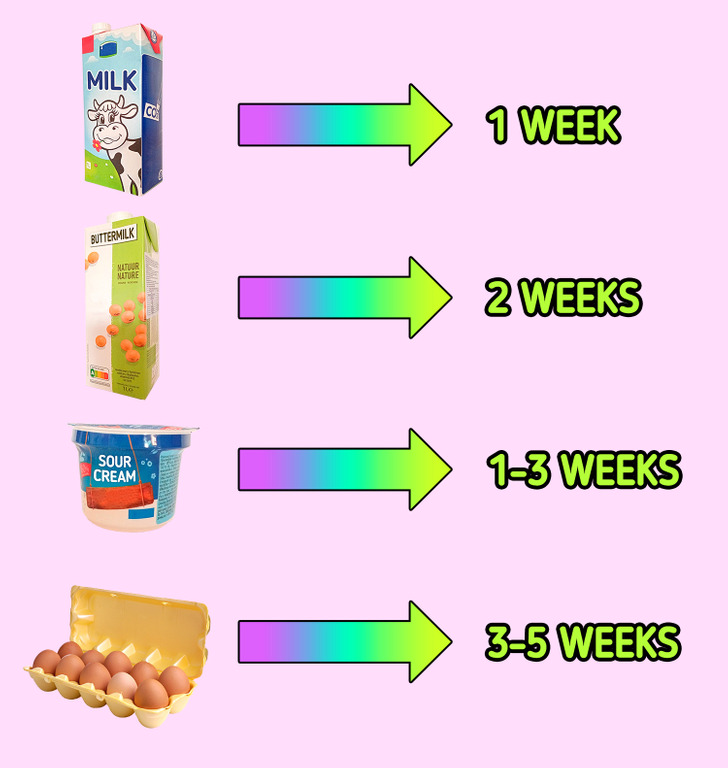
- Milk: 1 week (3 months frozen)
- Buttermilk: 2 weeks (3 months frozen)
- Sour cream: 1-3 weeks (don’t freeze)
- Eggs: 3-5 weeks after storing them in the fridge; hard-boiled: 1 week (if frozen: 12 months, but don’t freeze eggs in their shells)
5. Fruits and vegetables
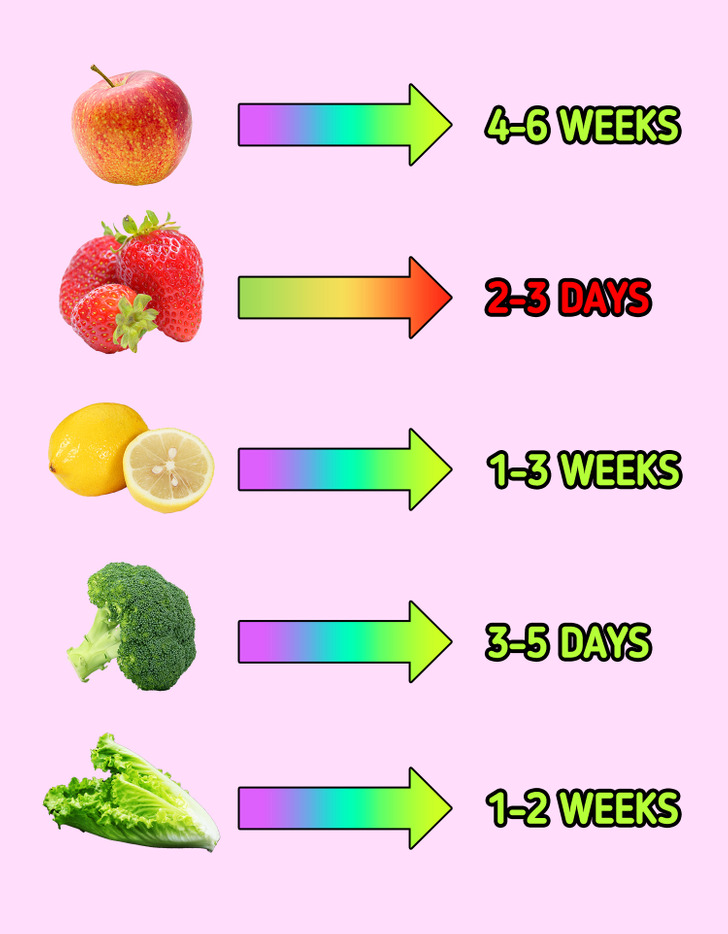
Avoid washing fruits and vegetables before placing them in the fridge because moisture can cause mold to grow. Clean them before you use them. If you are placing them in a bag be sure to use the breathable ones because fruits and vegetables let out gasses that can speed up the rotting process. Also, keep them away from any meat or seafood — it’s best to store them in crisper bins and drawers that most fridges usually have.
- Apples: 4-6 weeks in the fridge (up to one week at room temperature)
- Berries have a very short shelf life, even in the fridge. Strawberries and raspberries: 2-3 days in the fridge; blueberries: 1-2 weeks (frozen berries: 12 months)
- Citrus fruits: 1-3 weeks in the fridge
- Broccoli and cauliflower: 3-5 days
- Greens, like lettuce: 1-2 weeks; spinach: 1 week; other green vegetables: up to 4 days
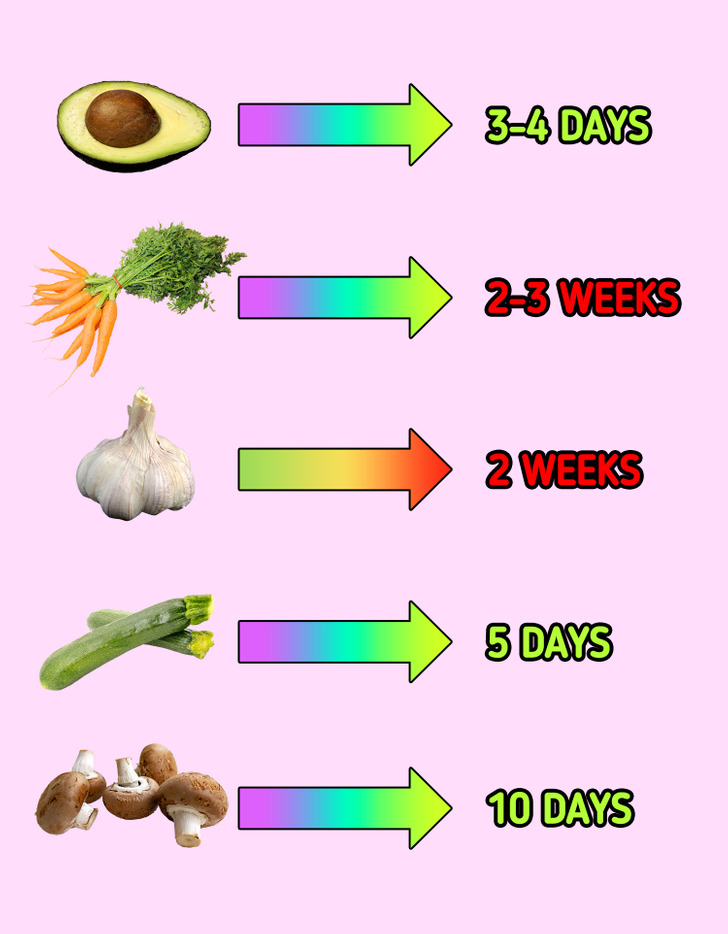
- Ripe avocado: 3-4 days
- Root vegetables, like carrots and parsnips: up to 3 weeks; radishes, turnips, and beets: up to 2 weeks
- Garlic: a couple of weeks; onions: 2 months
- Summer squash and zucchini: up to 5 days; winter squash (butternut and acorn squash): up to 3 months
- Mushrooms: up to 10 days (depending on their condition)
Note: Some fruits and vegetables shouldn’t go in the fridge, like bananas and tomatoes. Although bananas can last 1-3 days in the fridge, the peel will turn black, and tomatoes should be stored in the fridge only if you cut them.